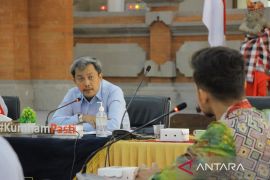For years it has been posing a serious problem and headache to areas such as Sukabumi in West Java, Cilacap in Central Java, and Kupang in East Nusa Tenggara.
In two separate locations in Sukabumi early Monday morning the police arrested around 42 illegal immigrants from the Middle East for trying to cross to Australia.
In Pelabuhanratu and Parungkuda, the police arrested the 34 illegal immigrants and confined them at Sukabumi Immigration detention center for further investigation, local immigration spokesman Ketut Arief said in Sukabumi after the arrest.
Ketut said that the 34 illegal immigrants, made up of 16 Iraqis, 15 Iranians, two Kuwaitis, and an Australian, were caught in a dawn operation after having been stalked for several days.
The police also seized four Iranian and an Australian passports, and a letter from the United Nations High Commissioner for Refugees (UNHCR).
"The illegal immigrants are planning to cross Sukabumi waters to Australia," Ketut said, adding that they were made up of five women and four children.
Ketut said the arrested illegal immigrants would be sent to Kalideres Immigration detention center in Jakarta but he was still waiting for word from the International Organization for Migration (IOM) about their fate.
Monday`s arrest of the Middle East illegal immigrants was not the firs.
Last year there has been four attempts of Middle East illegal immigrants to cross Sukabumi to seek asylum in Australia.
Meanwhile Ciemas sector police spokesman Adjunct Commissioner Suaryoto said he had known in advance that the illegal immigrants were trying to cross Sukabumi to Australia.
"Knowing that the illegal immigrants would cross to Australia, we immediately launched a sudden raid but it turned out they have been arrested outside our jurisdiction in Pelabuhanratu and Parungkuda," Sumaryoto said.
According to him, Ciemas was frequently used by illegal immigrants to cross to Australia to seek asylum.
The arrest of 34 illegal immigrants in Sukabumi on Monday came after 18 others, accommodated in Cisarua, Bogor, West Java, were sent to a third country on April 12, 2011.
"The 18 are accepted in Australia. We saw them off at Jakarta`s Soekarno-Hatta airport on Monday," head of supervision and enforcement of the Bogor immigration office, Fifi Fatimah said.
She said the 18 illegal immigrants came from several countries such as Iraq, Iran, Sri Lanka and Afghanistan.
"They consist of men and women and some of are even married couples," she said.
She said the immigrants that had been received in a third country have already lived in the immigration center in Cisarua for several years.
The immigrants were sent by the International Organization for Migration and supervised by the Bogor immigration office.
Fifi said there are around 300 illegal immigrants in the immigration accommodation centers in Cisarua and Tajur, Bogor.
She added that their number kept increasing following the arrival of another 33 from Surabaya and Bali several days earlier.
On April 27, the immigration office in Cilacap, Central Java, also detained 52 illegal immigrants from Iran and Iraq suspected trying to seek asylum in Australia.
Head of surveillance and repression at the Cilacap Immigration Office, Samsu Rizal, said that judging from the evidence found on the illegal immigrants, they were trying to seek asylum in Australia through Christmas Island.
Samsu said five of them had identity cards issued by the United Nations High Commissioner for Refugees (UNHCR).
Still, the immigration office would verify the authenticity of the UNHCR-issued identity cards, he said.
Cilacap immigration officers had difficulty recoding their data because most of them could not speak English.
"Only one of the immigrants spoke a little English, so communication with them is difficult. Therefore we still don`t know precisely how many of them are Iranian and how many Iraqis because they refused to be questioned. They wanted to be accompanied by UNHCR or IOM representatives," he said.
Meanwhile police in Kupang, East Nusa Tenggara, suspected that a syndicate had exploited local fishermen to smuggle the illegal immigrants to Australia.
"The fishermen from Oelaba and Pepela villages on Rote island bordering Australia usually were fishing in Australia`s Ashmore Reef know well there, and therefore they might be exploited by the syndicate to smuggle the illegal immigrants to the country," East Nusa Tenggara Police spokesman Adjunct Senior Commissioner Lilik Apriyanto said in Kupang early in April.
The head of the anti-people smuggling task force of the East Nusa Tenggara regional police command said he made the conclusion after studying information from the owner of a stranded fishing boat with 142 illegal immigrants from the Middle East at Ndao Island.
"Based on the results of our investigation into a number of cases we found that skippers of the boats that carry illegal immigrants from the Middle East have always been from Oeleba and Pepela although the boats may come from Java, Sulawesi or West Nusa Tenggara," he said.
Therefore he believed that a syndicate had recruited the fishermen to cross the illegal immigrants to Australia. (*)
Reporter: Otniel Tamindael
Editor: Aditia Maruli Radja
Copyright © ANTARA 2011










